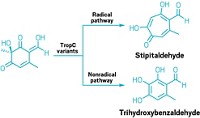Advertisement
Grab your lab coat. Let's get started
Welcome!
Welcome!
Create an account below to get 6 C&EN articles per month, receive newsletters and more - all free.
It seems this is your first time logging in online. Please enter the following information to continue.
As an ACS member you automatically get access to this site. All we need is few more details to create your reading experience.
Not you? Sign in with a different account.
Not you? Sign in with a different account.
ERROR 1
ERROR 1
ERROR 2
ERROR 2
ERROR 2
ERROR 2
ERROR 2
Password and Confirm password must match.
If you have an ACS member number, please enter it here so we can link this account to your membership. (optional)
ERROR 2
ACS values your privacy. By submitting your information, you are gaining access to C&EN and subscribing to our weekly newsletter. We use the information you provide to make your reading experience better, and we will never sell your data to third party members.
Synthesis
Analysis of 40 years’ worth of patents reveals pharma reaction trends
Analysis of 200,000 patents issued from 1976 to 2015 unravels how medicinal chemists conduct research and how drug discovery has changed
by Stephen K. Ritter
April 22, 2016
| A version of this story appeared in
Volume 94, Issue 17
A massive computer-guided text mining of pharmaceutical industry patents has helped elucidate what kinds of reactions have been run most often by medicinal chemists over the past 40 years.
Previous efforts to dissect the “medicinal chemist’s toolbox” in this way have focused mainly on parsing selected sets of research journals or data from company electronic lab notebooks. For the new study, lead author Nadine Schneider of the Novartis Institutes for BioMedical Research and her colleagues considered that far more medicinal chemistry is revealed in patents.
The Novartis team, working with researchers from NextMove Software, a company developing chemistry informatics tools, turned up 1.3 million unique chemical reactions along with molecule data from 200,000 U.S. patents issued from 1976 to 2015. They report their analysis highlights in a research paper in the Journal of Medicinal Chemistry (2016, DOI: 10.1021/acs.jmedchem.6b00153) and include complete data in the paper’s supporting information and supplemental interactive online graphics.
The team’s sprawl of information reveals the waxing and waning of chemists’ bread-and-butter reactions as the research landscape has evolved with new strategies and new classes of drugs. For example, Suzuki-Miyaura couplings have moved to the fore, and although some classics such as Wittig olefinations have declined as a result, others such as the Grignard reaction have held steady. Overall, the findings show an increase in the number of reaction types and a trend toward lower product yield. They also show that today’s molecules are larger, have more aromatic rings, are more hydrophobic, and are more rigid than those from 40 years ago.





Join the conversation
Contact the reporter
Submit a Letter to the Editor for publication
Engage with us on Twitter